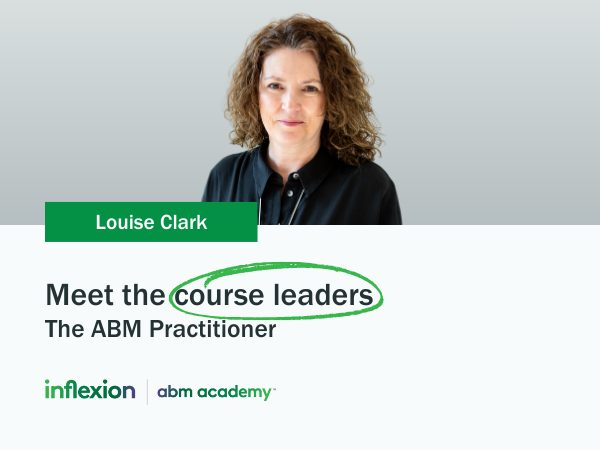This type of ABM is famously difficult to do well, and yet the most common approach used today, due to its ability to scale across more customers and prospects while still appearing highly personalised and relevant to each one. But how are people using it?
- Almost everyone in Inflexion Group’s ABM Benchmarking Study is using Segment ABM; a massive 94%.
- The majority are using it for existing customers, but there is a significant group who also use it to engage new prospects, or for a mix of accounts.
- It is most often used in the top 20% of customers (outside of the absolute top 1% where Strategic ABM is preferred). Alongside Programmatic ABM, it is a common choice for engaging with target prospects.
- Most companies bring together an average of ten companies into a cluster for this type of ABM, but the range spans from 5 to 50 companies.
- One approach used to select accounts for the cluster is to start with what ABM-ers call a ‘grandfather’ account. This is where an existing customer receiving Strategic ABM is used as the archetype around which to build a cluster of similar accounts (as demonstrated in the Virgin Media O2 case study).
- Most companies tailor existing content for Segment ABM accounts, personalising around 20% of the content for a specific stakeholder and company and leaving 80% untouched.
- Segment ABM plans rely on more of a blend of digital and offline channels than 1-1 ABM approaches. Digital advertising is reported as the most useful tactic, followed by paid social media and innovation workshops, then webinars, VIP event experiences and executive engagement initiatives.
- Typical spend on a segment during the year is $95k, or roughly $9.5k per account in a cluster of 10.
Orchestrating activation across customer facing teams to deliver a streamlined engagement plan becomes more complex for the ABM-er in Segment ABM. Since there are multiple account or sales leaders to collaborate with, clarity over the plan, and then a shared view of progress against it across all stakeholders is important, especially as you adapt your approach once you see how things are landing with your audience. One company that got this internal alignment right for their retail segment is Virgin Media O2.
Segment ABM in action at Virgin Media O2
Virgin Media and O2 joined forces in 2021 in the UK to create Virgin Media O2 (VMO2). O2 had a mature ABM strategy, running a highly successful 1-1 programme for its priority enterprise customers in line with its customer-first ethos. By contrast, Virgin Media had never adopted an ABM approach. That changed after the merger, with ABM promoted as a way to drive significant revenue growth and get stakeholder buy-in for the newly formed organisation.
Choosing accounts for the programme was based on extensive data and insight, according to Gerry Davies, Head of Key Accounts Marketing & Advocacy. She and her team work closely with both the insight and sales teams to identify the accounts with high potential based on a strong propensity to buy, the relationships within the account, and any white space revenue opportunities.
“What we have learned is that you can’t take a data-only approach to account prioritisation, particularly for strategic ABM… Often the data might indicate a prime target, but once we have a conversation with sales to get the full story and it shows otherwise, we remove it from the list.”
Moving to a vertical approach
In early 2024, the company decided to experiment with a more clustered vertical approach focused on retail organisations.
“We looked at our base in terms of customers and prospects and identified the retail sector as our sweet spot with the best opportunities,” explains Davies. “This was partly based on the number of customer ‘use cases’ we had in place in the sector, but the real driver was that we already had one a one-to-one programme running for a strategic retail account – a major high street retailer – so we had already gone through the insight phase for the retail market and the individual customer’s key performance indicators (KPIs). It made sense to use that background insight work to expand across a larger group of companies with similar context and challenges rather than reinvent the wheel.”
Davies carried out a rigorous exercise with the insight team and sales to confirm exactly who should be in the cluster and, in the process, they created an ideal customer profile. The prioritisation process resulted in a large cluster consisting of 50 customer and prospect accounts. And while the ‘grandfather’ one-to-one ABM account had unique challenges to address, the team felt they could put together an impactful narrative for the cluster campaign based on that work and the commonalities across the accounts.
Developing a close relationship with sales
One of the factors in ensuring the campaign’s success has been the relationship the ABM team built with sales. The ABM team worked hard to develop a good relationship with the new head of retail sales and her team, ensuring they were completely aligned on the cluster initiative.
A customer success manager and business development manager were assigned to each customer account, while prospects in the cluster were dealt with by a business development manager.
“We wanted to make sure that we were creating a really immersive retail enablement experience for the sales team, so that they didn’t just understand the retail market challenges and where our solutions could help, but that they also understood how our ABM approach was designed to drive our objectives around relationships, reputation and revenue (the three Rs), and their role in achieving them at each stage of the campaign,” explains Davies.
Hitting the right targets
The campaign was designed around three propositions: improving customer experience, customer convenience, and operational efficiency. Once the buyer personas or decision-makers and influencers for each one were mapped out, an engagement plan was drawn up to establish VMO2’s credibility and build sufficient interest to secure a meeting.
The multi-channel campaign included LinkedIn, content syndication, email, social selling, a webinar and outbound calling; all pointing towards dynamically-personalised landing pages on the Folloze platform.
“It’s important to highlight how hugely beneficial the insight we gathered at the top level for every single account was for the business development teams throughout all the activity,” Davies declares. “They loved it because, despite not having strong relationships with these accounts, we were able to profile the people who make decisions on these propositions, or who influence them. Our teams could refer to the individuals’ challenges and KPIs, enabling them to have an informed conversation around the ways in which VMO2 could add value.”
Within a month of the campaign launching, we were able to identify five retail organisations who were highly engaged with the campaign and ripe for a further in-depth approach.
This approach to promoting defined propositions to individuals in a tight cluster is one that Jess Shea from Bain & Company recognises, referring to Segment ABM as a multi-client pursuit.
A perspective from Jess Shea
How would you define Segment ABM and how does it differ from other types in your view?
To me Segment ABM is like a multi-client pursuit. It’s different from Strategic ABM where you have an account-based marketer embedded into the client team, acting like the CMO to build programmes that reinforce the commercial objectives of the sales team.
In this case, the opportunity has already been defined. You know what you want to sell to a handful of clients who are usually in the same sector. They are facing a similar challenge, and they’re at a similar stage in how they are addressing or trying to address that challenge. So, you as an ABM-er can use the same approach to talk to each of them about how your business can help.
What do you see as the key steps in the segment ABM process?
I think the most important thing is to make sure you have expertise in the business where you spot potential opportunities. Do you have a strong point of view? Is there a natural segment of clients where this would be particularly relevant? Is there a match between what you offer and what they are struggling with? That interlock of sector and topic is the sweet spot.
Then you have to convince them that you are the right choice as partner. That differs from Strategic ABM, where there is a close relationship and understanding of commercial aims and concerns. Having an established brand can also play a key role.
The next step is to develop material for them. You might already have something that can be tailored, or you have to create something new. Most organisations have a lot of content scattered that can be adapted and re-used. Figure out how you can reposition it appropriately and personalise for each individual you are aiming at; technology allows you to do that easily.
What are the main interlocks and dependencies in this process?
Technology is definitely one. You wouldn’t be able to send emails or put anything on your website without it. Having said that, technology is an essential part of the overall marketing activity in most organisations, so it doesn’t feel specific to ABM. It’s just used in a different way.
I think having the right intellectual property (IP) is critical. And it’s OK if the IP you need is not always what’s coming out of the marketing engine as long as there’s a process that allows ABM teams to create their own, quickly. This is about being a little bit more turnkey than some longer-form IP. Webinars are great for this. If you don’t feel you have a meaty piece of IP you can host a webinar on the topic and it becomes a great asset. You’ve got the recording. You’ve got snippets from it. You can take quotes from the transcript. There’s a lot of things you can do with a webinar.
What are some of the challenges specific to this type of ABM?
To me the biggest challenge is the danger of proliferation. You are going to find some of your colleagues are keen to keep adding clients into the programme. ABM-ers can address this by using data to influence how they thoughtfully and strategically cull down the list to a segment that is much more meaningful and will have a greater impact.




